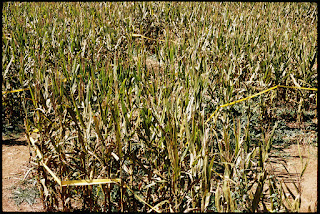The Rolleicord I was also known as the "Tapeten" model in Germany, which means "Wallpapered" - for obvious reason. I am unsure of why they covered the camera with this design, but I have read online a theory that this was marketed as a camera for women. Either way, they also released the same model with plain leather covering in smaller numbers (about 32,000 were made in the Art Deco design, with only about 5,000 with plain leather). Subsequent Rolleicord models were all normal leather coverings. This model is specifically notated as the K3 - 510 model.
As you can see, my camera here is in fairly good condition, with just a few battle scars and such. Collector interest in these cameras seems high so finding one in good condition can cost a bit of money. I found this camera on eBay for pretty cheap, but it needed a CLA on the lens. A bit of TLC and the camera is now in tip-top shape. In my experience, these older Rollei's (which are getting up to 60, 70, or 80 years old) all have sluggish shutters or even non-working shutters unless already serviced sometime \in the past couple of decades. Don't expect a sight-unseen camera from someone who doesn't know about them (or even those that do!) to work without a hitch.
These early Rolleicords come equipped with a Zeiss 7.5cm f/4.5 Triotar lens - a simple, uncoated triplet lens (3-element). While the triplet was supposedly a cheaper lens compared to the Rolleiflex's Tessar (4-element) lens, I find the Triotar to be a unique lens and excellent in its own way. The Triotar is softer in the far corners, but is quite sharp when stopped down a bit and also has a nice rendering of the image. It can and does flare easily in direct light, especially due to being uncoated, so a hood is recommended. Online, you'll find numerous sites that claim the filter size is 28.5mm screw-in. This is wrong! The filter is 28.5mm slip-on, while the inner screw mount appears to be about 25.5mm according to my calipers. I've ordered a filter step-up ring to test this theory and will update this post accordingly. The early Rolleiflex clamp-on lens hood works on the Rolleicord, with 28.5mm filters slipping into the hood via a second clamp - a must-have accessory in my opinion! By the way - this all applies to the later Rolleicord I and Ia models as well (I have a Ia to compare with).
Finally, some notes on film loading and handling: the earliest Rolleicords have no automatic film loading/indexing, no automatic frame counting, and no double-exposure prevention. Loading the film is done simply, without any special handling, but you then have to use a red window on the bottom of the camera to wind to Frame 1. At this point you press down on a small switch on the side opposite the focus to reset the counter to 1. This spring on both my Rolleicords is weak after 70-80 years so sometimes you have to coax the frame counter to reset (the later Rolleicords have a redesigned frame reset system requiring one to both push down on the button and push the middle button on the wind knob). Interestingly, when winding, you have to index a tiny dash next to the frame number yourself. There is NO automatic stop! This feature was put in to the model Ia, making this the only model with no automatic stop, meaning you have more control of the film winding if you want to overlap frames. Also, the film winding and shutter cocking/firing is not coupled, as in all early Rolleicords and Rolleiflexes as well. So you can double-exposure your film at will.
So, how do images from this camera look? The Triotar lens has a nice "snap" to the image, with softer contrast than modern lenses which gives nice full shadows. Center sharpness at all apertures is excellent. As I mentioned before, you have to stop down to get sharp corners.
Here are some black and white images shot at around f/8 or f/11:
Out-of-focus rendering is nice and smooth - one of the hallmarks of triplet lenses. Images have a genuinely 3-D look to them when the subject is brought into sharp focus in front of a busy background:
Flare can be a problem even with a hood when you have a very bright foreground:
What about color? Despite many people consider uncoated lenses to be poor for color, I enjoy the slightly muted colors and lower contrast rendered by this lens. Here are some images from Provia 100F:
The slides are wonderfully luminous on my light table. I wouldn't hesitate to shoot positives with this camera, and in fact I really like these as they scan a little easier than ones shot with modern, super high-contrast lenses.
For reference, I will mention here that some of these images were shot with my Rolleicord Ia, also equipped with the same 7.5cm f/4.5 Triotar. They should render equivalently. Also, I would like to mention that I took some information from the Rollei Club website on Rolleicords - you should check it out for all sorts of information on Rolleiflex and Rolleicord cameras based on the serial numbers.
Overall, this is a wonderful camera. While many other cameras can do basically the same thing, it is certainly cool to have and use such a unique and unusual-looking camera.
Anything I missed? Something you'd like to know about this camera? Feel free to ask or comment below. Thanks for reading!





















































